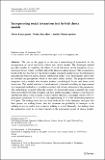Incorporating social interaction into hybrid choice models
Author(s)
Kamargianni, Maria; Polydoropoulou, Amalia; Ben-Akiva, Moshe E.
Download11116_2014_Article_9550.pdf (587.0Kb)
PUBLISHER_CC
Publisher with Creative Commons License
Creative Commons Attribution
Terms of use
Metadata
Show full item recordAbstract
The aim of this paper is to develop a methodological framework for the incorporation of social interaction effects into choice models. The developed method provides insights for modeling the effect of social interaction on the formation of psychological factors (latent variables) and on the decision-making process. The assumption is based on the fact that the way the decision maker anticipates and processes the information regarding the behavior and the choices exhibited in her/his social environment, affects her/his attitudes and perceptions, which in turn affect her/his choices. The proposed method integrates choice models with decision makers’ psychological factors and latent social interaction. The model structure is simultaneously estimated providing an improvement over sequential methods as it provides consistent and efficient estimates of the parameters. The methodology is tested within the context of a household aiming to identify the social interaction effects between teenagers and their parents regarding walking-loving behavior and then the effect of this on mode to school choice behavior. The sample consists of 9,714 participants aged from 12 to 18 years old, representing 21 % of the adolescent population of Cyprus. The findings from the case study indicate that if the teenagers anticipate that their parents are walking lovers, then this increases the probability of teenagers to be walking-lovers too and in turn to choose walking to school. Generally, the findings from the application result in: (a) improvements in the explanatory power of choice models, (b) latent variables that are statistically significant, and (c) a real-world behavioral representation that includes the social interaction effect.
Date issued
2014-09Department
Massachusetts Institute of Technology. Department of Civil and Environmental EngineeringJournal
Transportation
Publisher
Springer US
Citation
Kamargianni, Maria, Moshe Ben-Akiva, and Amalia Polydoropoulou. “Incorporating Social Interaction into Hybrid Choice Models.” Transportation 41.6 (2014): 1263–1285.
Version: Final published version
ISSN
0049-4488
1572-9435